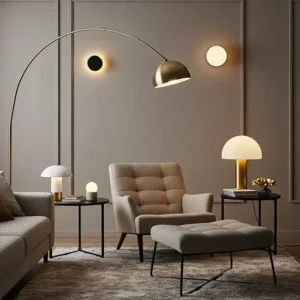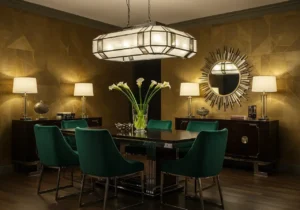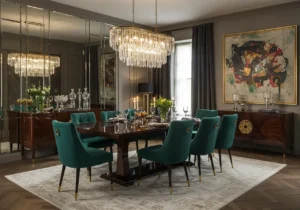Hey there, fellow decor lovers! If you’re anything like me, you’re obsessed with creating spaces that feel uniquely ‘you’. And let me tell you, there’s something incredibly cool and effortlessly chic about the industrial look, especially in a dining room. It’s all about celebrating raw materials, showcasing history, and creating a vibe that’s both strong and inviting. I’ve spent countless hours pouring over ways to bring this edgy style into our homes, and today I’m so excited to share my favorite 13 industrial dining room looks with you. Get ready to transform your eating space into a stylish loft-inspired retreat!
Embrace Exposed Brick for Industrial Dining Room Style
There’s nothing quite like exposed brick to instantly scream ‘industrial loft’. It adds incredible character and a sense of history to a space. It’s one of the first things I look for when trying to capture that authentic industrial vibe.
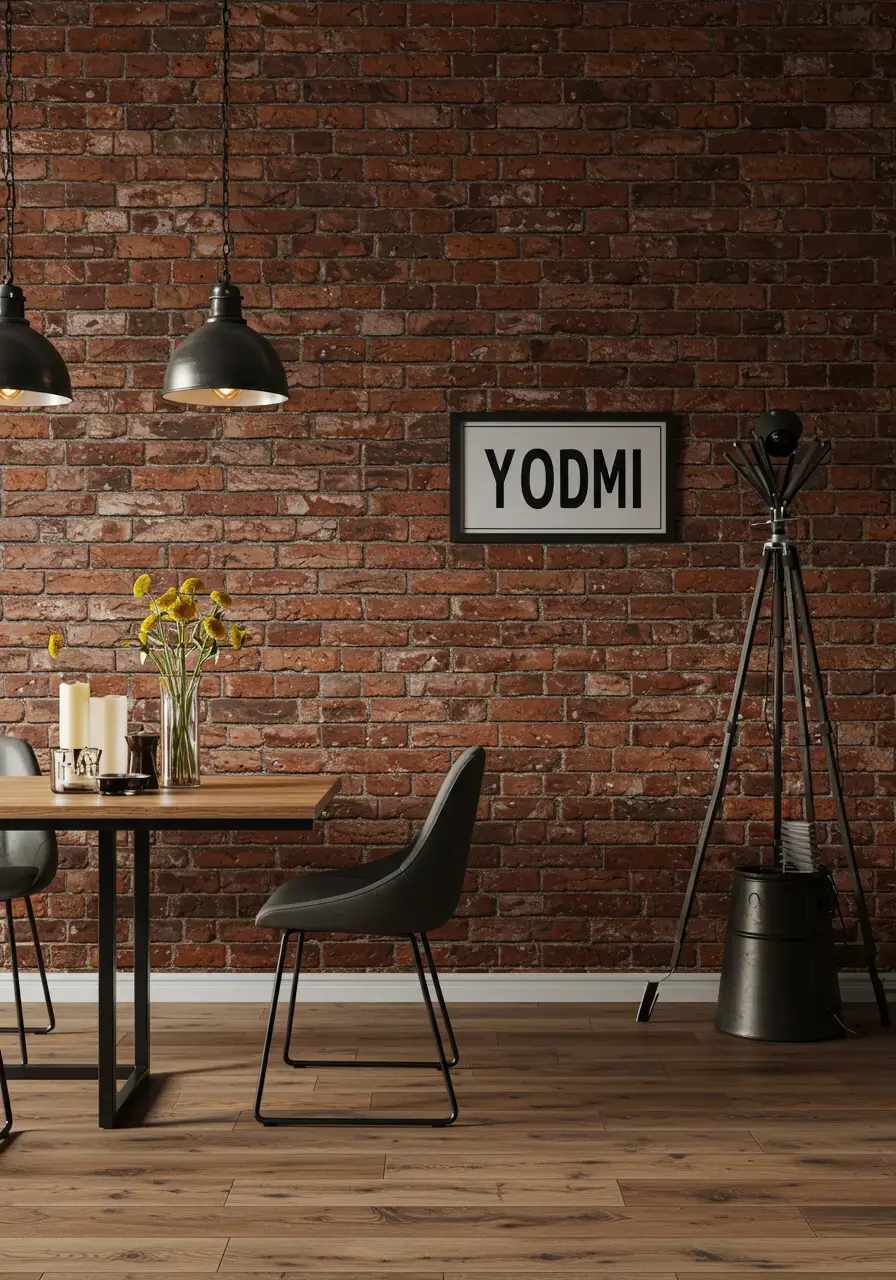
Why This Works:
Exposed brick walls add texture, warmth, and an authentic, aged feel that is fundamental to industrial design. It creates a raw, unfinished look that grounds the room.
How You Can Recreate It:
- Assess your walls – do you have brick hidden behind drywall?
- If you can’t expose real brick, consider brick veneer or even realistic brick-patterned wallpaper.
- Keep other wall decor minimal to let the brick be the star.
Add Industrial Dining Room Charm with Metal Seating
Metal chairs are a staple of industrial design. Think classic Tolix-style chairs or simple metal stools. They bring that utilitarian, factory-floor feel that’s essential to the style. I remember finding a set of old metal stools at a flea market; they added so much character! Traditional dining room styles offer a different takes on seating.
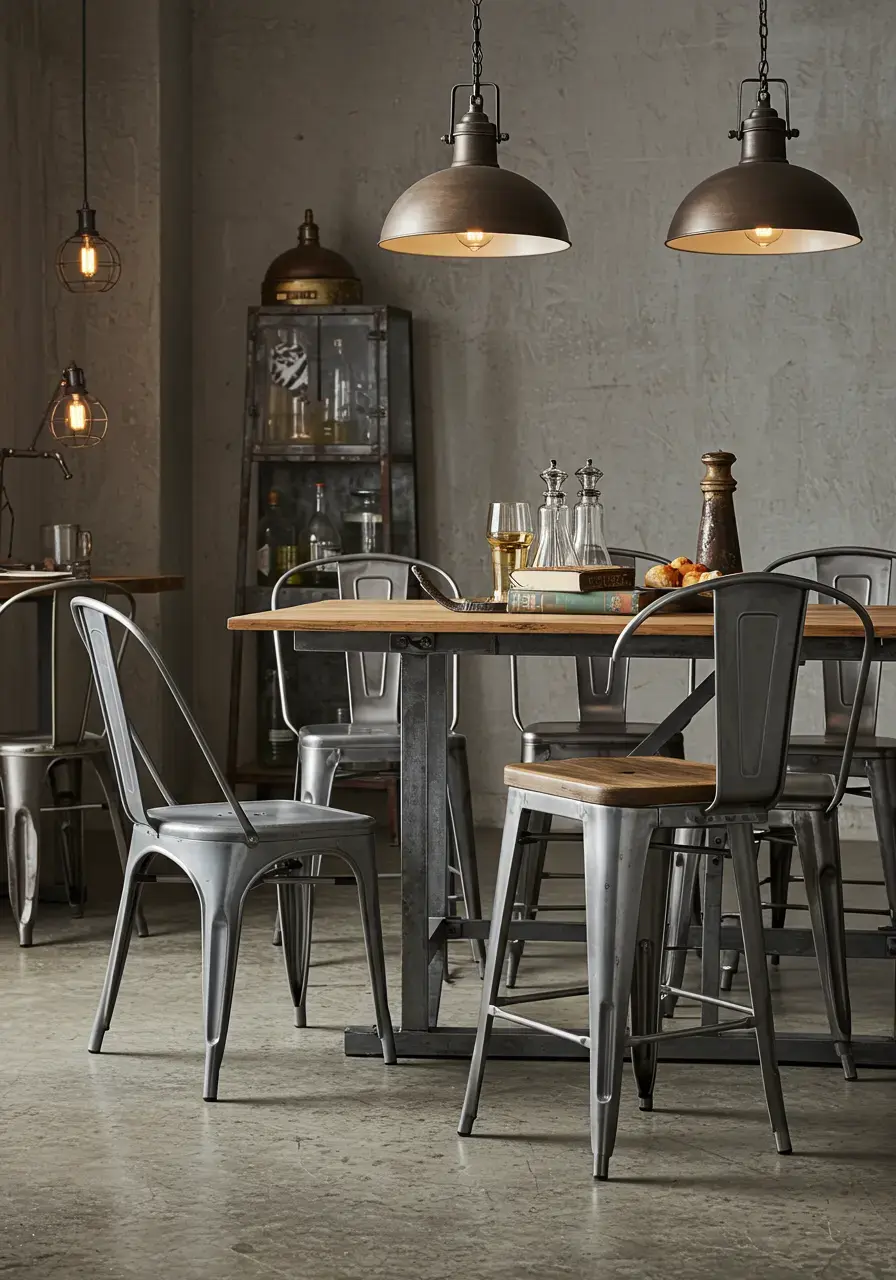
Why This Works:
Metal seating introduces the strong, durable materials characteristic of industrial spaces. It adds a touch of rawness and can provide a nice contrast to other textures like wood or concrete.
How You Can Recreate It:
- Look for chairs made of steel or iron.
- Consider finishes like matte black, brushed metal, or even distressed paint.
- Mix and match different metal chair styles for an eclectic feel.
Illuminate Your Industrial Dining Room with Pendant Lights
Lighting is key! Industrial style often features pendant lights with exposed bulbs or metal shades. They hang low, creating a more intimate and focused light over the dining table. It’s like bringing a piece of a factory or workshop into your home, but in a super stylish way.
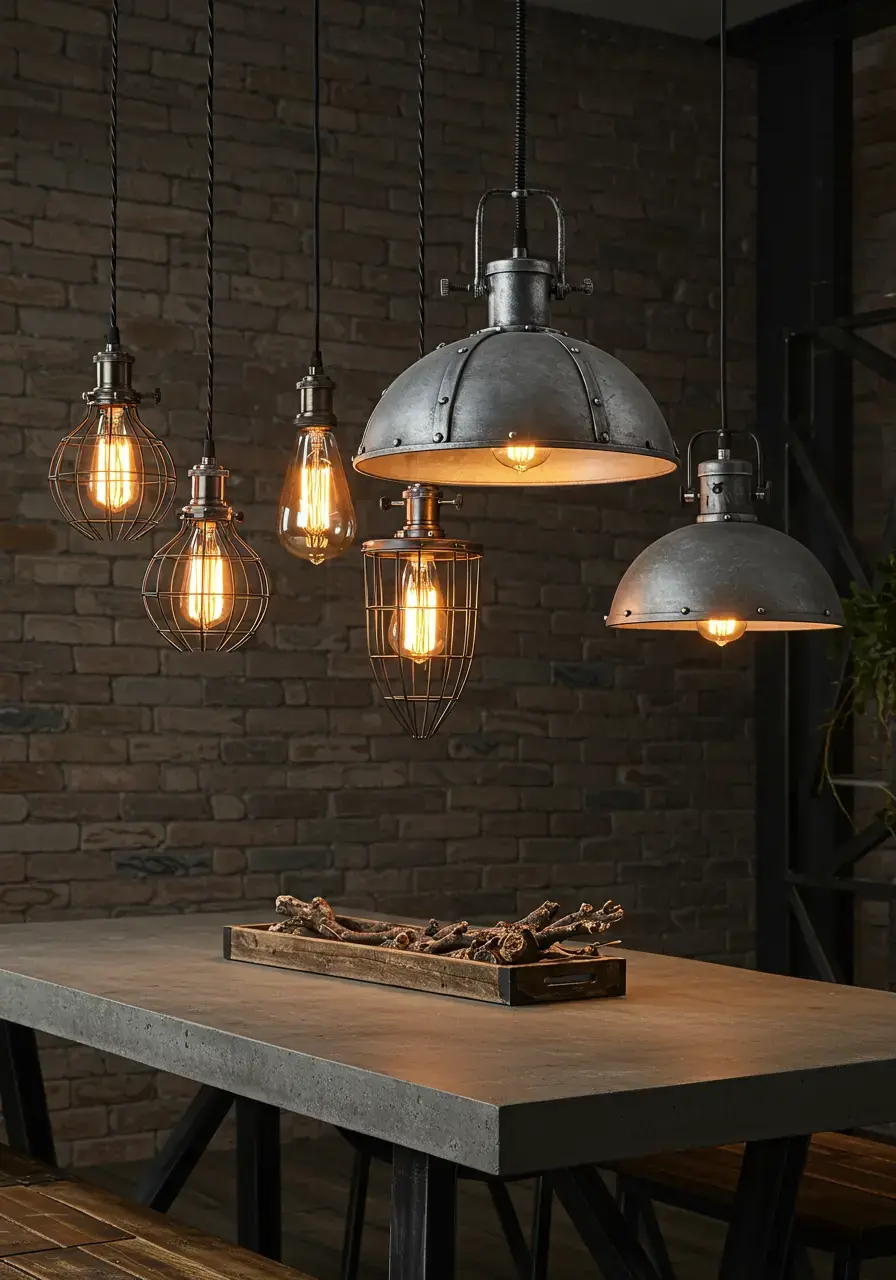
Why This Works:
Industrial pendant lights provide task lighting for the dining area while also acting as a significant design element. They draw the eye and reinforce the utilitarian aesthetic.
How You Can Recreate It:
- Choose pendants made from metal, glass, or even concrete.
- Consider exposed filament bulbs (Edison bulbs) for a vintage touch.
- Hang one large pendant or a cluster of smaller ones over the table.
n
Incorporate Reclaimed Wood in Your Industrial Dining Room
Reclaimed wood tells a story. Using it for your dining table, a bench, or even shelving adds warmth and a sense of history. It pairs beautifully with the harder elements of industrial style, creating a lovely balance. My dining table is actually made from old barn wood, and I love thinking about its past life!
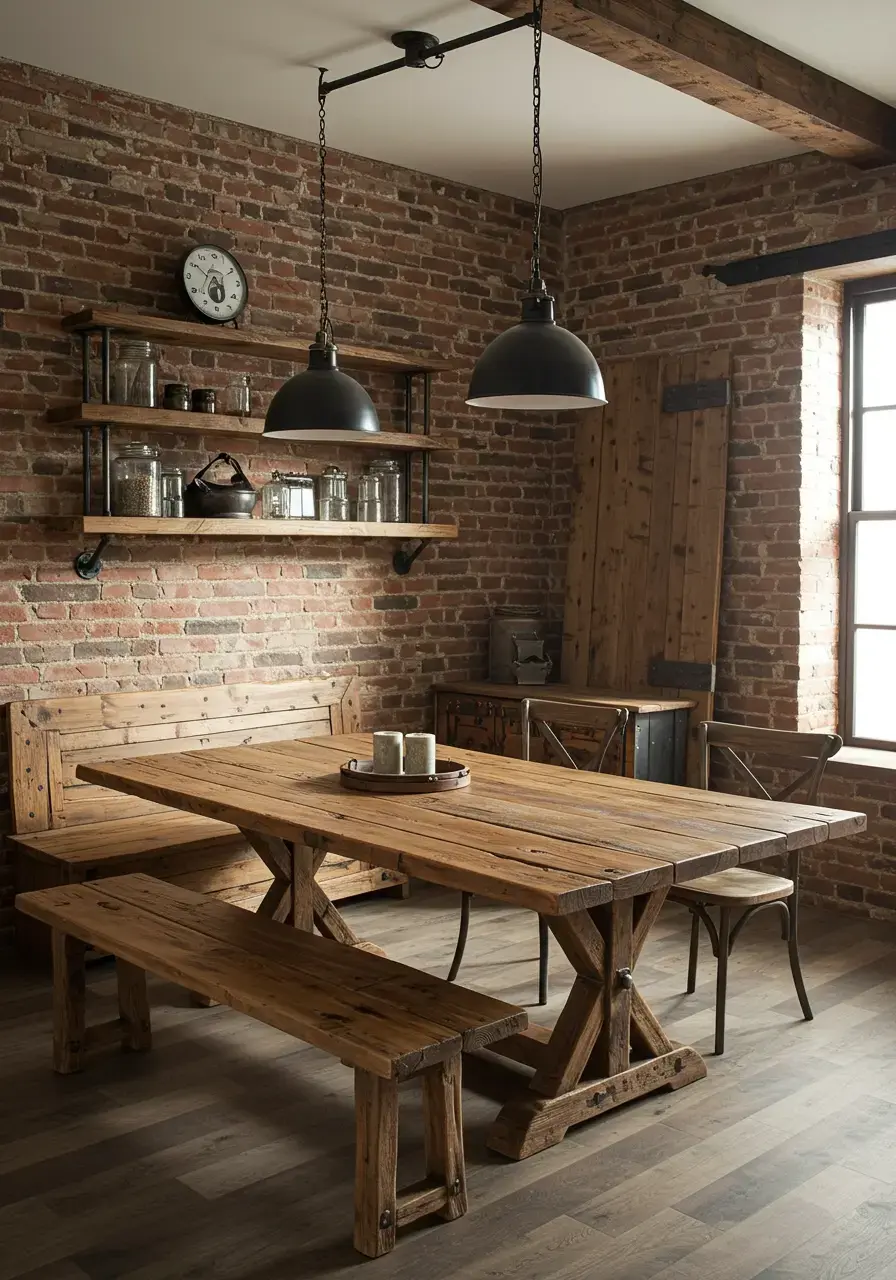
Why This Works:
Reclaimed wood adds warmth, texture, and a sense of sustainability. Its imperfections and natural variations enhance the industrial aesthetic by suggesting age and past use.
How You Can Recreate It:
- Look for dining tables made from salvaged wood.
- Add a bench or chairs with reclaimed wood seats.
- Install shelving made from old planks and pipe brackets.
Display Art with an Edge in Your Industrial Dining Room
While the industrial look can seem minimalist, it’s a great canvas for art that has a bit of an edge. Think abstract pieces, black and white photography, or art that uses industrial materials like metal. It’s about adding personality without clutter.
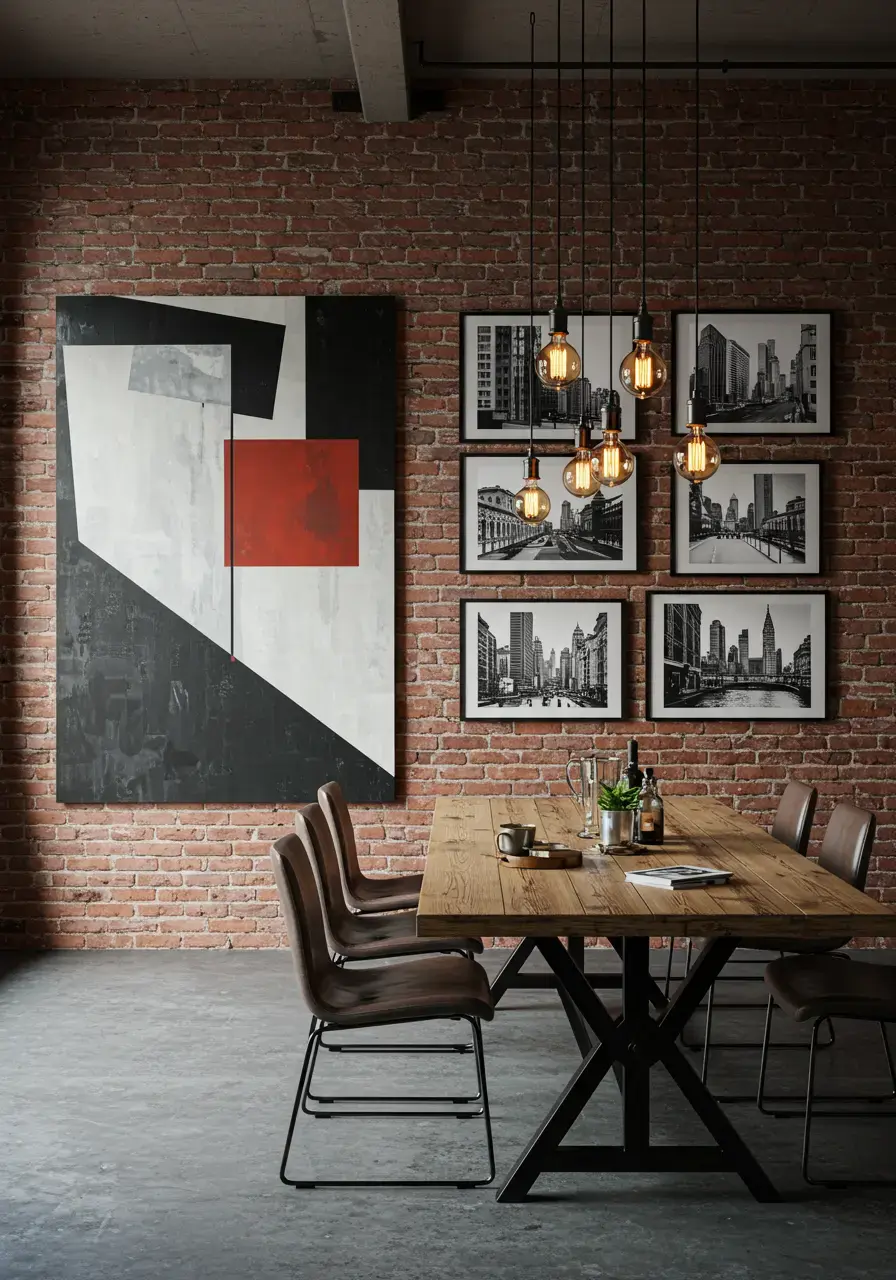
Why This Works:
Edgy art adds personality and a point of interest. It complements the raw nature of the industrial style and allows you to infuse your own taste.
How You Can Recreate It:
- Choose art with strong lines, geometric shapes, or bold colors against muted backgrounds.
- Display black and white photos of cityscapes or industrial scenes.
- Consider artwork printed on metal or canvas.
Choose Concrete tabletops for Industrial Dining Room Appeal
Concrete isn’t just for floors and walls anymore! A concrete tabletop adds a cool, modern, and undeniably industrial element to your dining space. It’s durable and has a lovely, understated texture.
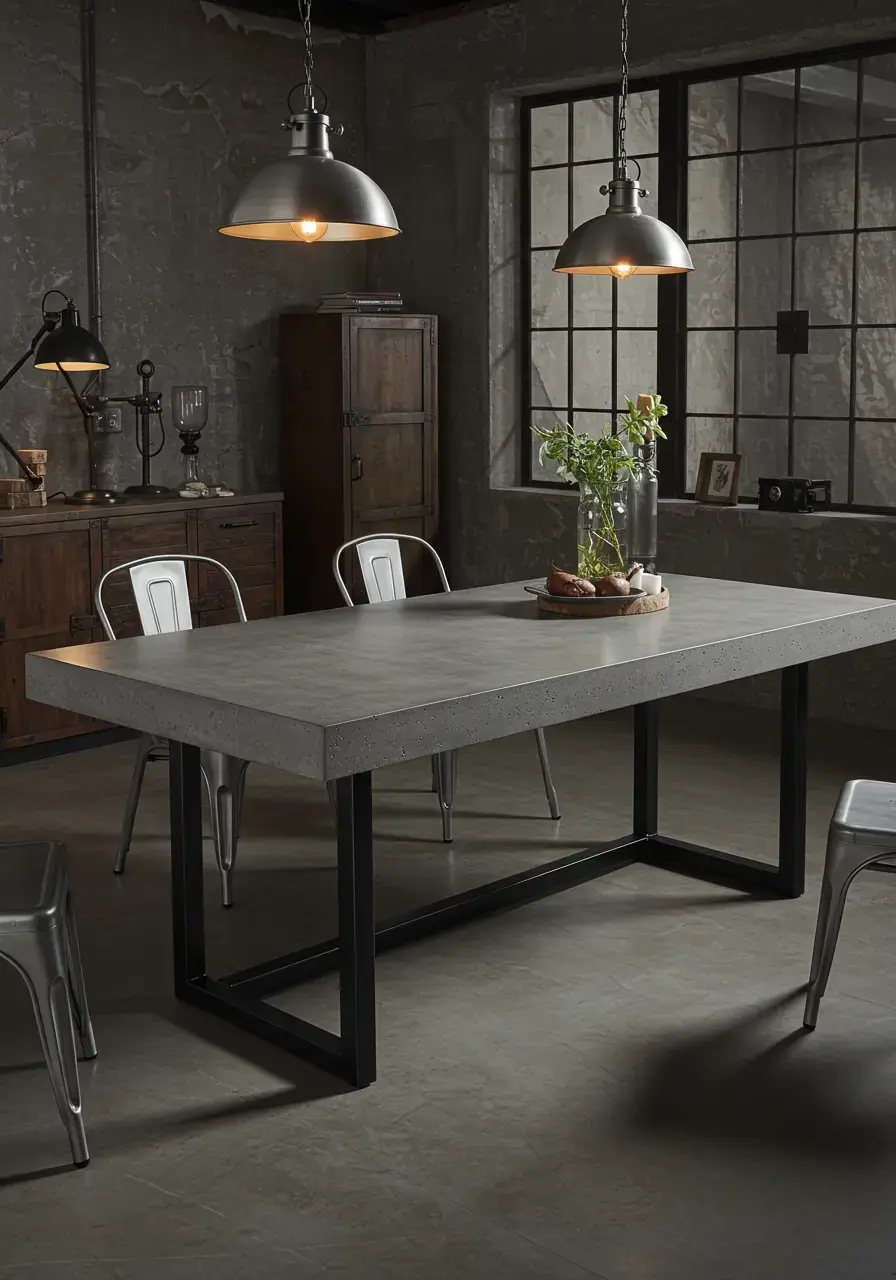
Why This Works:
Concrete is a core material in industrial settings. Using it for a tabletop introduces strength, weight, and a raw, unfinished texture that defines the style.
How You Can Recreate It:
- Find a dining table with a concrete or concrete-look top.
- Consider a DIY project to create a concrete overlay on an existing table.
- Use concrete placemats or coasters for smaller touches.
Style Shelving with Found Objects
Industrial style celebrates function and salvaged items. Style open shelving with things that look like they could have been found in an old factory or workshop – gears, metal crates, vintage bottles, or old tools. It tells a visual story about utility and history.
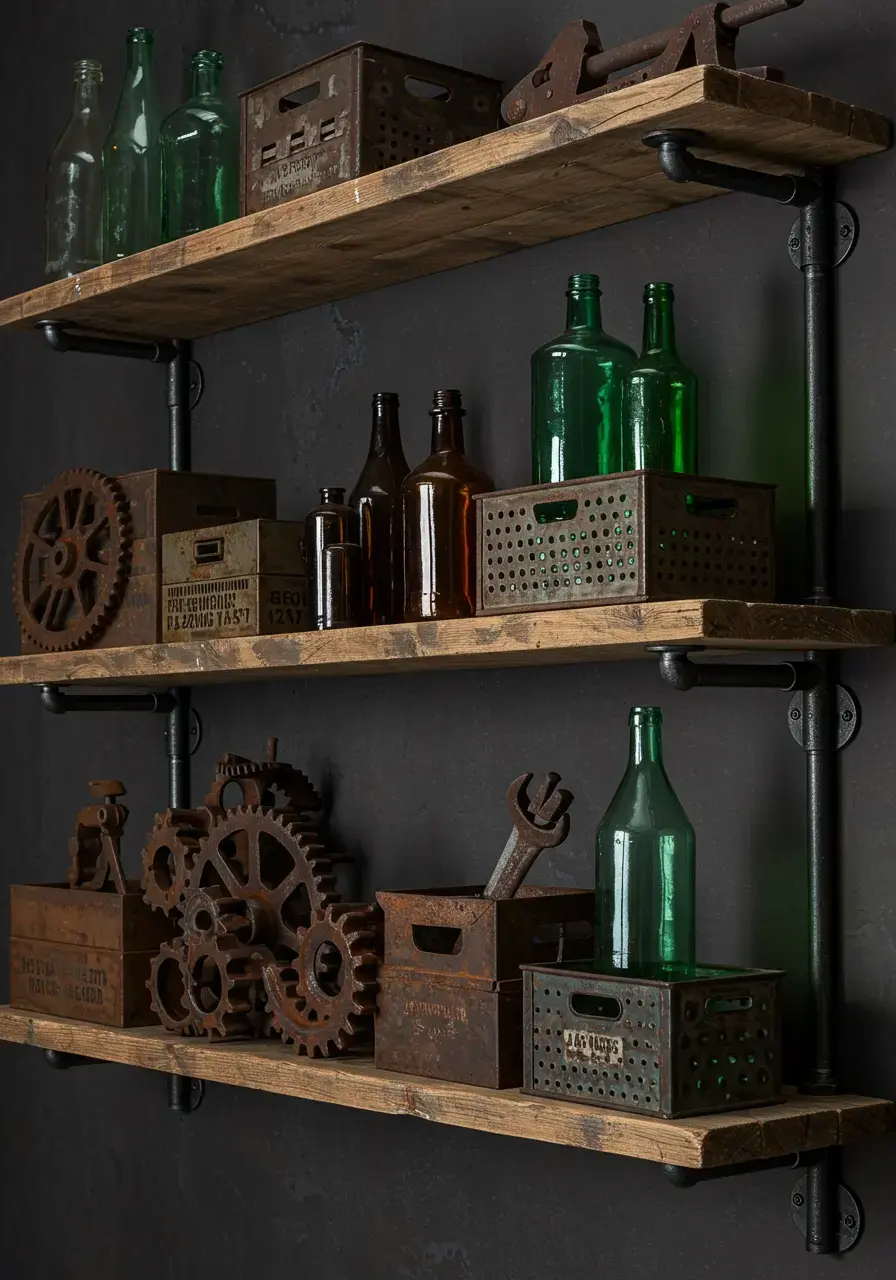
Why This Works:
Styling with found objects reinforces the salvaged, utilitarian aspect of industrial design. It adds authenticity, visual interest, and a sense of discovery.
How You Can Recreate It:
- Install open shelving using pipe brackets and wood or metal shelves.
- Hunt for unique items at antique shops, flea markets, or even hardware stores.
- Group similar objects together or mix different types for visual variety.
Layer Textures for an Industrial Dining Room Look
Industrial style isn’t just rough edges! Layering different textures is key to making it feel welcoming. Combine metal, wood, brick, concrete, and even soft textiles like a rug or cushions. This creates visual interest and keeps the space from feeling too cold.
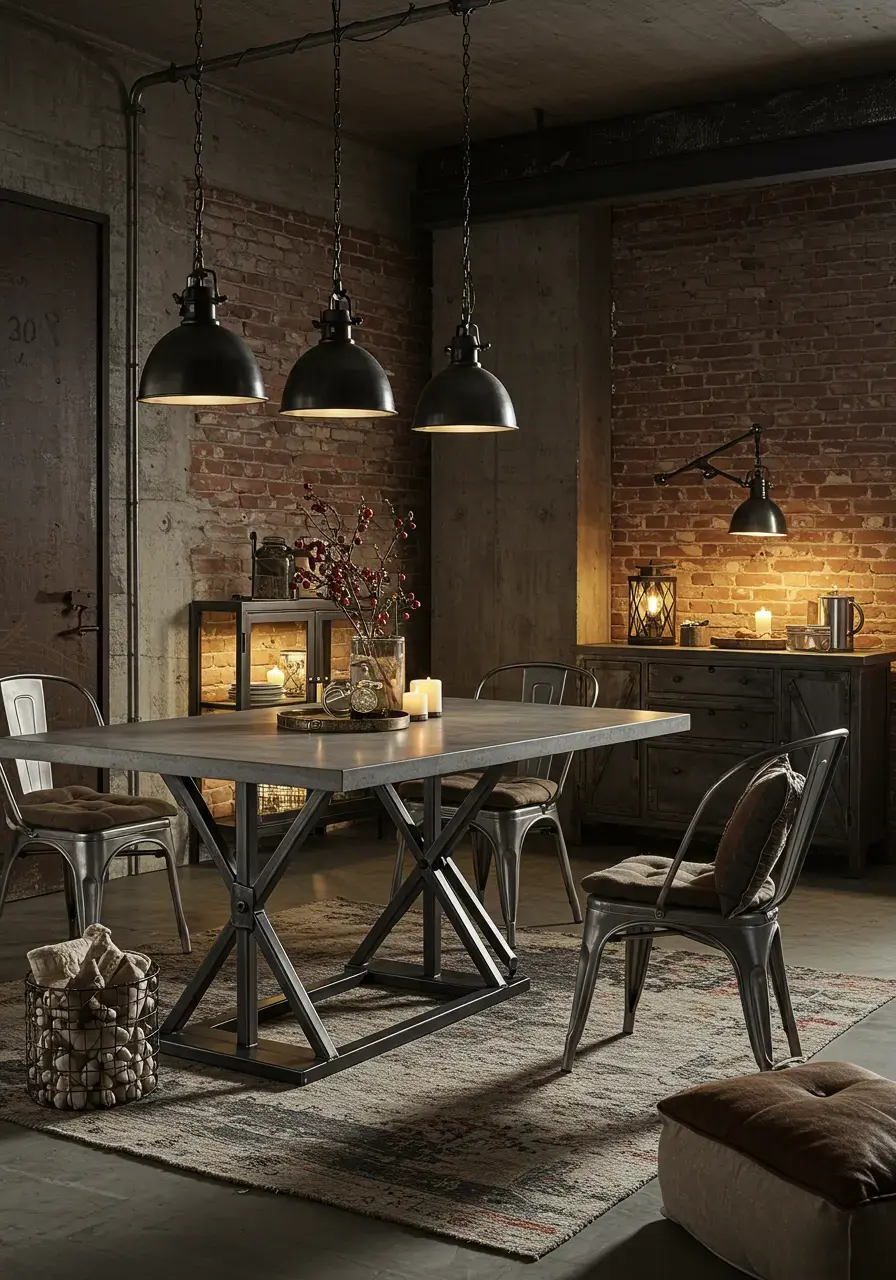
Why This Works:
Layering textures adds depth, visual interest, and a multi-sensory experience to the room. It softens the harder elements and makes the space feel more inviting and dynamic.
How You Can Recreate It:
- Combine a metal table base with a wood top.
- Place metal chairs around a concrete table.
- Add a soft rug under the dining table and textile cushions on the chairs.
Consider Oversized Fixtures
Go big or go home with your light fixtures! Oversized pendant lights or a dramatic chandelier can become a major focal point in an industrial dining room. They command attention and reinforce that larger-than-life factory scale.
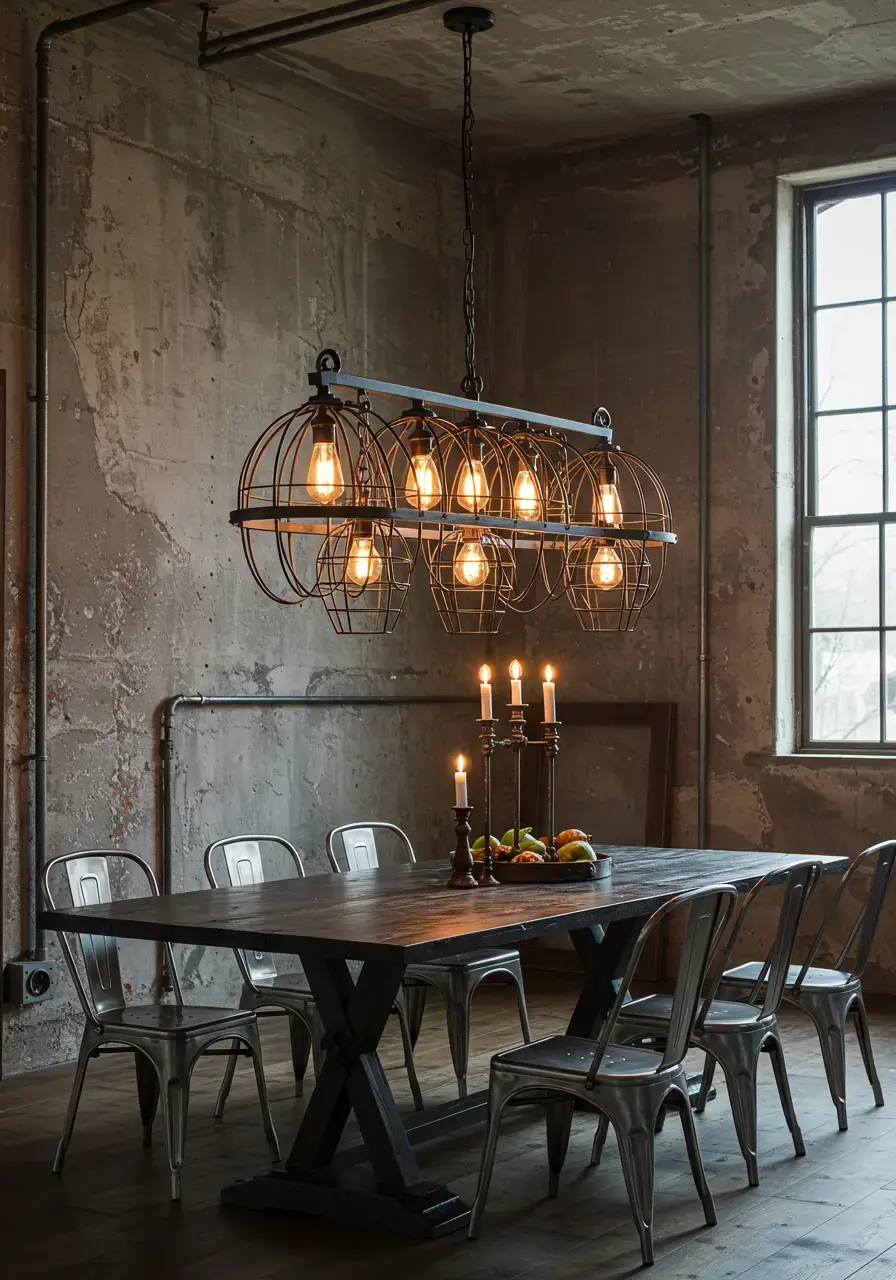
Why This Works:
Oversized fixtures make a bold statement and act as central design elements. They draw the eye upwards and contribute to the sense of scale often associated with industrial spaces.
How You Can Recreate It:
- Look for pendant lights or chandeliers that are significantly larger than standard size.
- Consider fixtures made from metal, cages, or with multiple exposed bulbs.
- Ensure the fixture is scaled appropriately for your dining table and room size.
Bring in Darker Color Palette
While you can use white, industrial often leans into a darker, moodier palette. Think charcoal grays, deep blues, black, and earthy browns. These colors enhance the raw, dramatic feel. It’s about creating a cozy, enveloped feeling. For color inspiration, explore mid-century dining room accents.
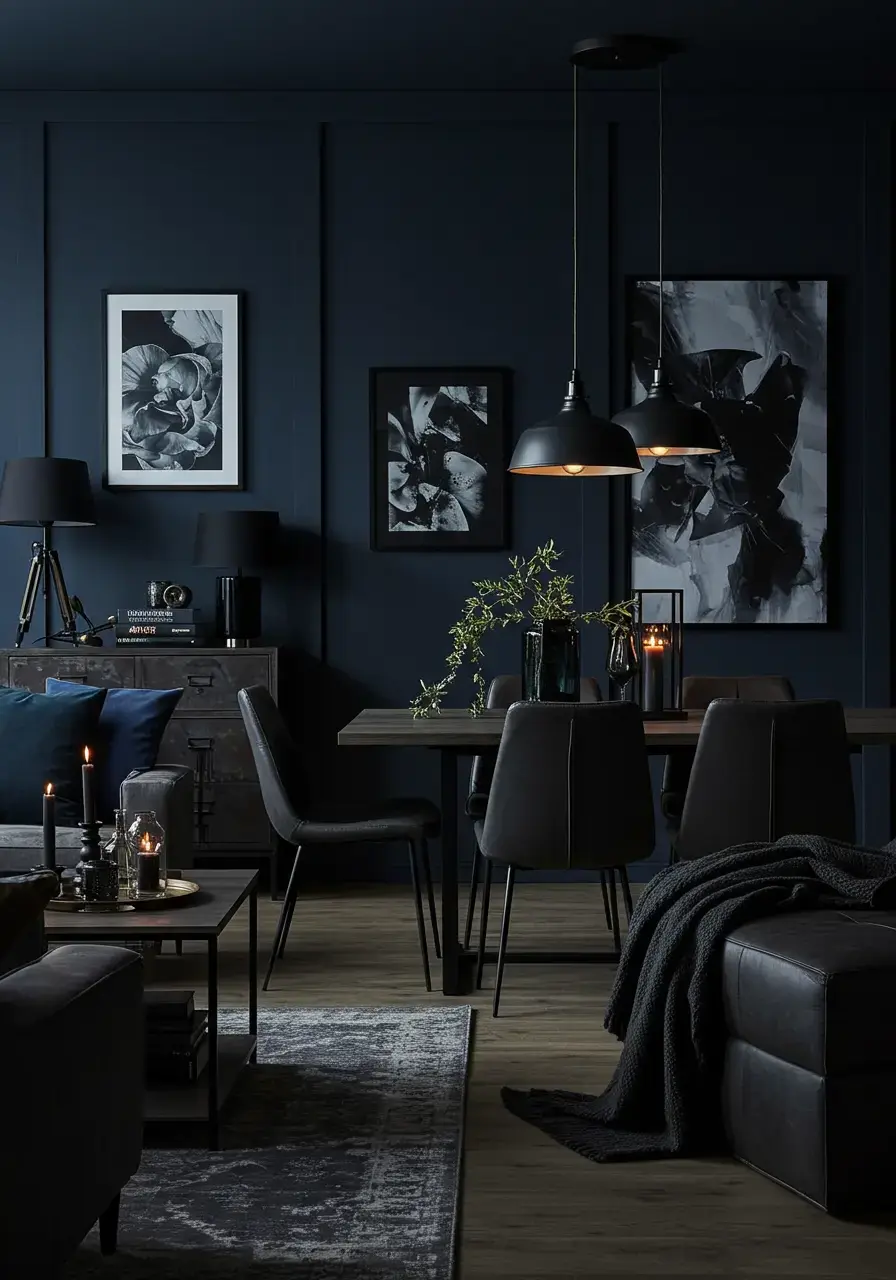
Why This Works:
Darker colors lend a sophisticated and dramatic feel to the industrial space. They enhance the feeling of depth and can make other elements like wood and metal pop.
How You Can Recreate It:
- Paint walls in deep gray, navy, or black.
- Choose dark-colored dining chairs or a table base.
- Incorporate dark accents like wall art, textiles, or decor items.
Maximize Natural Light
Industrial spaces often have large windows, letting in lots of natural light. This contrast between the light and the dark, raw materials is part of the appeal. Keep window treatments minimal to let the light flood in.
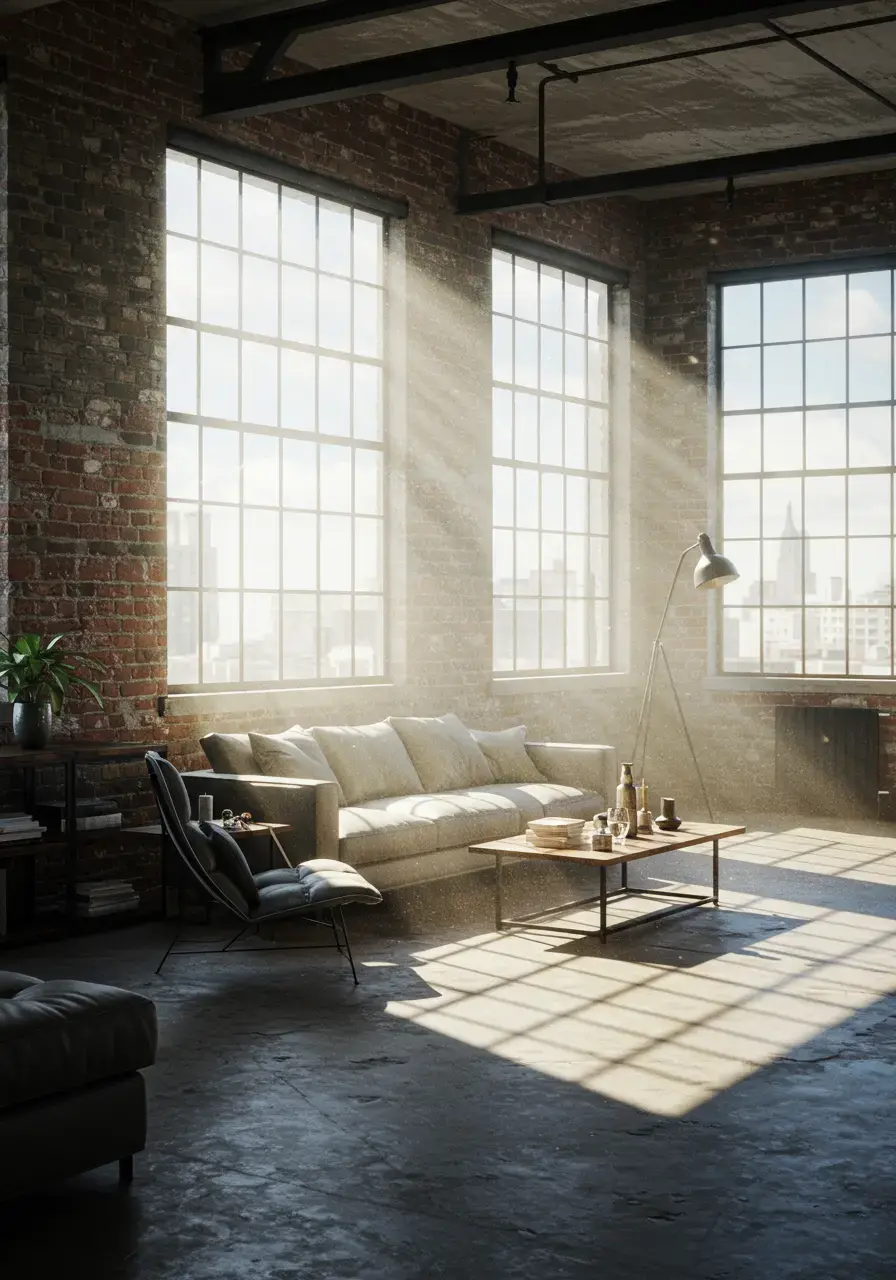
Why This Works:
Natural light brightens the space and creates a beautiful contrast with the heavy, dark industrial elements. It also improves mood and makes the room feel more open and airy.
How You Can Recreate It:
- Avoid heavy curtains; opt for blinds, simple shades, or leave windows bare if privacy allows.
- Keep window panes clean to maximize light entry.
- Place furniture in a way that doesn’t block incoming light.
Use Vintage Area Rugs in Industrial Dining Room
A vintage or distressed area rug can soften the hard edges of an industrial dining room and add a layer of comfort and color. Look for rugs with worn patterns or muted colors that complement the overall palette. It feels lived-in and cozy.
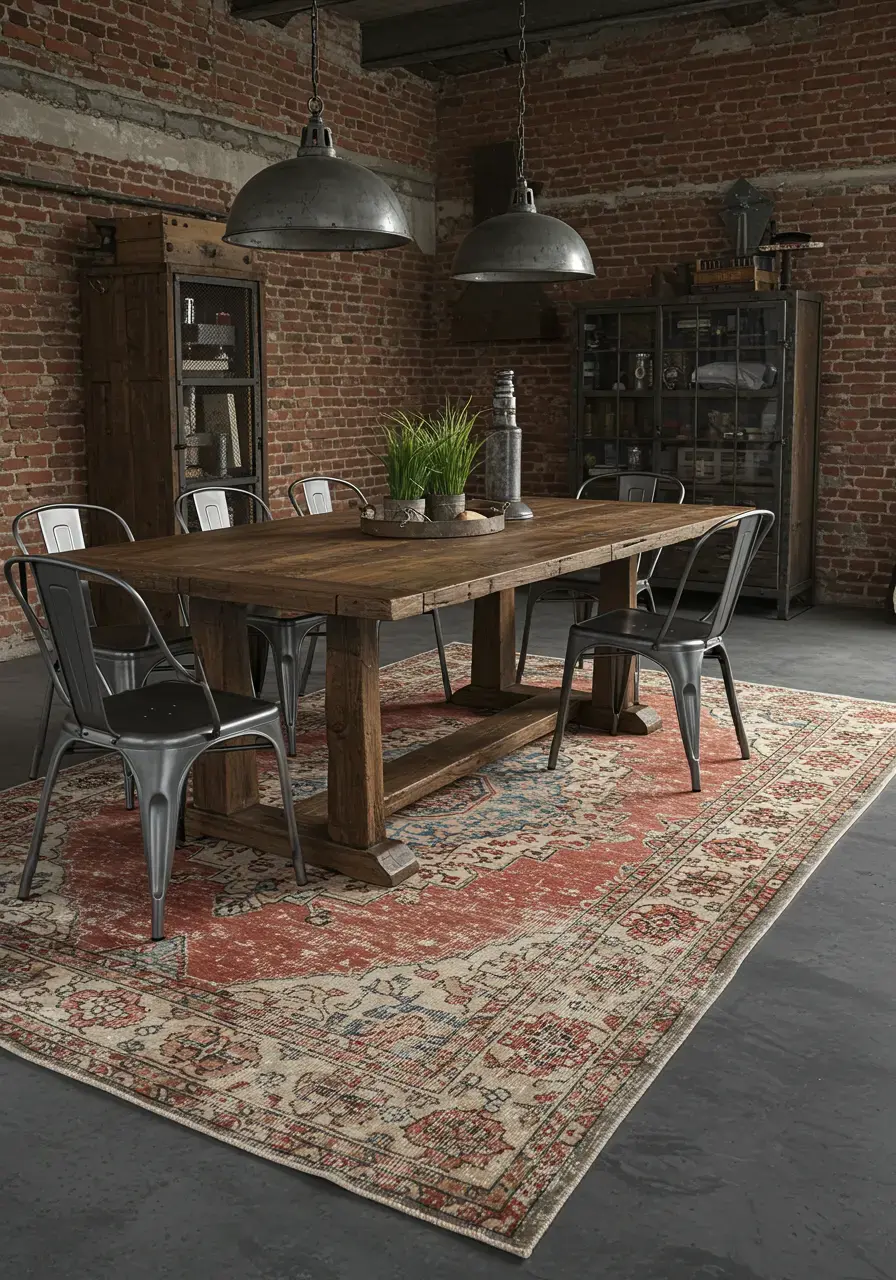
Why This Works:
A vintage rug introduces warmth, texture, and subtle color, contrasting with the harder industrial elements. It defines the dining area and makes the space feel more grounded and comfortable.
How You Can Recreate It:
- Choose a rug size that fits comfortably under your dining table and chairs.
- Look for rugs with abstract patterns, tribal designs, or faded traditional motifs.
- Consider materials like wool or cotton for warmth and texture.
Create a Focal Point with a Statement light
Beyond just pendant lights, one truly standout light fixture can transform your industrial dining room. This could be an oversized chandelier, a unique sculptural piece, or even track lighting in a raw finish. It’s the design element that grabs attention the moment you walk in.
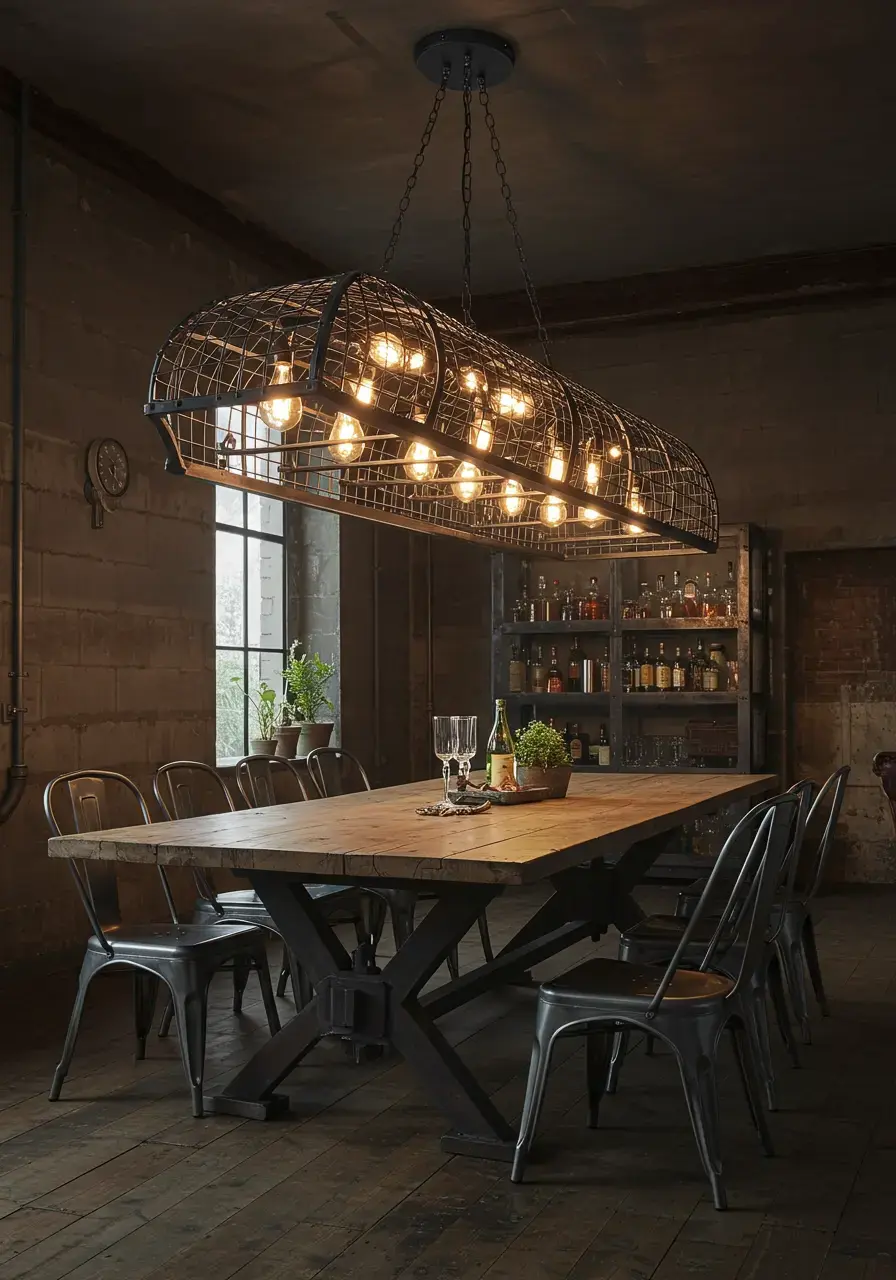
Why This Works:
A statement light acts as the main focal point, adding drama and highlighting the dining area. It showcases your personal style and reinforces the intention behind the design.
How You Can Recreate It:
- Select a light fixture that embodies the industrial style but has a unique twist.
- Ensure the size and scale are appropriate for the room.
- Install it directly over the center of your dining table.
Conclusion
Incorporating these 13 industrial dining room looks can truly transform your eating space into something special. It’s all about balancing raw, strong elements with touches of warmth and history. Experiment with different textures, materials, and lighting to find the perfect mix that reflects your style. You’ll find creating that stylish loft vibe is not only achievable but incredibly rewarding!

